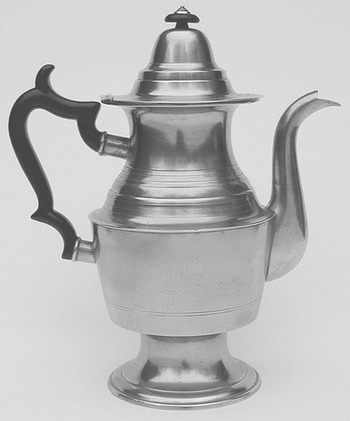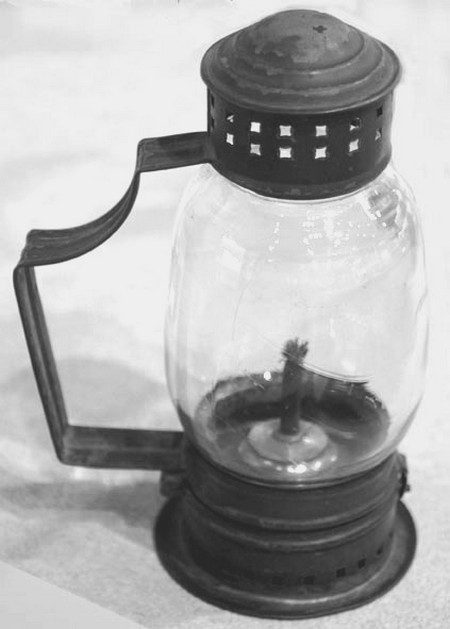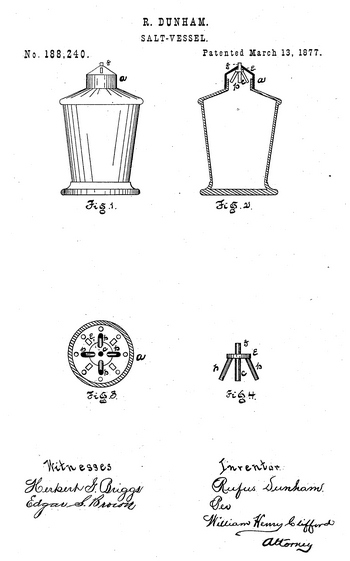Rufus Dunham
- Born: 1816, Biddeford ME
- Marriage (1): Emma Bedelia Sargent on 25 Aug 1845 in Portland ME
- Marriage (2): Emmaline S. Stevens
- Died: 20 Sep 1893, Deering ME
General notes:
Pewtersmith and silverplater
Events in his life were:

- He worked circa 1837-1863 as a pewtersmith and silverplater in Westbrook ME

- Example: Teapot, circa 1840, in Private Collection. H: 8"
- Apprenticed: Allen Porter, in 1831-1833, in Westbrook ME.
He recieved two suits of clothes per annum, his board, and fifty dollars in cash. In 1833 he broke his contract because he was not paid for overtime hours worked. He spent the next four years working in the shop of Roswell Gleason and then moved on to a shop in Poughkeepsie. There he purchased molds and tools, eventually returning to Westbrook to set up on hs own accord.

- Example: Coffeepot, circa 1840, in Private Collection. H: 11 7/8"

- Example: Water pitcher, circa 1845, in Private Collection. H: 6 1/4"
d: 4 1/2" (at base)

- Example: Coffeepot, circa 1850, in Private Collection. H: 9 1/2"
- He appeared on the census in 1850 in Westbrook ME. Listed as a britannia worker.

- Example: Whale oil lamp, circa 1860, in Private Collection. H: 9"
d: 4 1/4" (at base)
- He appeared on the census in 1860 in Westbrook ME. Listed as a britannia ware manufacturer.
- He worked in 1863-1877 as a pewtersmith and silverplater in Portland ME from a shop at 218 Fore Street.

- Example: Lantern, circa 1865, in Maine State Museum.

- He was issued patent number 50,567 on 24 Oct 1865
RUFUS DUNHAM, OF PORTLAND, MAINE
IMPROVEMENT IN LANTERNS.
Specification forming part of Letters Patent No. 50,567, dated October 24, 1865.
To all whom it may concern:
Be it known that I, Rufus Dunham, of Portland, in the county of Cumberland and State of Maine, have invented a new and useful Improvement in Hand-Lanterns; and I do hereby declare the following to be a fall, clear, and exact description of the same, reference being had to the accompanying drawings, making part of this specification, in which—
Figure 1 represents a view of my improved lantern, embodying my improvements; Fig. 2, a section of Fig. 1, showing the mode of operation; Fig. 3, the catch by which the frame holding the globe or shade is secured to the body of the lamp.
The object of my invention is to produce a lantern which shall be light, portable, less liable to accident from fracture of the shade than heretofore, and which embodies certain new and useful improvements, hereinafter enumerated and described.
My invention consists of a lantern the glass shade of which and the parts into which the shade is fitted can be turned off from the body of the lamp without being detached entirely therefrom. This method of operation is represented in Fig. 2, the hinge or joint upon which the shade or globe portion of the lantern is turned being shown at a.
My invention further consists in fitting the shade or movable part of the lantern with a handle, which serves not only to carry or lift the lantern by, but also as a rest for the shade when thrown back for the purpose of lighting or replenishing the lamp, &c, and thus prevent it from accidental fracture, as in Fig. 2.
It also consists in fitting the lower part, c, Fig. 1, of the movable part of the lantern with the catch represented at Fig. 3, to hold the shade in its proper position when the lamp is lighted. The catch consists of two links, b and c c, Fig. 3, the first of which is secured by soldering to the rim c, the second hanging in the first so as to swing backward and forward. When the movable portion of the lantern is swung into its place the link c c, Fig. 3, will fall over the projection d, Fig. 2, and thus hold the shade, &c, securely over the flame of the lamp.
I construct my improved lantern of tin, brass, or any other suitable metal, fitting the glass B to the parts A and 0 by the ordinary process. To the parts A and C, I fasten the handle before described. The shade or movable portion is permanently attached to the body of the lamp by the hinge a. The catch b c c is constructed of the same material as the body of the lamp, and in the manner described.
What I claim as my invention, and desire to secure by Letters Patent, is—
The combination of the movable shade B, the parts A and 0, and the handle E, as and for the purposes described.
Rufus Dunham
Witnesses:
William H. Clifford
Hanno W. Gage
- He appeared on the census in 1870 in Westbrook ME. Listed as a britannia manufacturer.

- Partnership: Joseph, Frederick, and Horace Dunham, in 1877-1893, in Portland ME. As R. DUNHAM & SONS.

- He was issued patent number 188,240 on 13 Mar 1877
RUFUS DUNHAM, OF DEERING, MAINE.
IMPROVEMENT IN SALT-VESSELS.
Specification forming part of Letters Patent No. 188,240, dated March 13, 1877; application filed January 24,1877.
To all whom it may concern :
Be it known that I, RUFUS DUNHAM, of Deering, in the county of Cumberland and State of Maine, have invented certain new and useful Improvements in Salt-Vessels; and I do hereby declare that the following is a full, clear, and exact description thereof, which will enable others skilled in the art to which it pertains to make and use the same, reference being had to the accompanying drawings, and to the letters of reference marked thereon, which form a part of this specification.
Figure 1 shows the vessel. Fig. 2 shows same in section. Fig. 3 is a bottom plan of cap and prongs. Fig. 4 is a side view of the disk and prongs.
The object of this invention is to produce an improved salt-receptacle which will keep the salt clean, break up lumps which may form in the same, and will also be a convenient article for use upon the table, for which it is designed.
I employ an ordinary vessel like a pepperbox, having its cover perforated with small holes.
I am aware that such vessels have before this been used to contain salt and to sprinkle it upon food. I do not claim such a vessel. My invention relates to an improvement in the cap or cover by which the salt is kept pulverized, prevented from becoming caked, and kept in such condition as to pass freely through the perforations of the top of the cap. The improvement consists of certain prongs, flaring or diverging so as to nearly fill the neck of the box or bottle. Any convenient number and arrangement of the prongs can be made, but they are shown in the drawing as several branching arms or prongs, and one in the center of these which extends directly down. These extend down a short distance in the neck of the bottle or box. The arms or prongs break up the salt when the box is turned upside down and shaken, and prevent it from packing into the head and becoming fixed there, and moreover, lumps striking against the prongs are broken and pass through the holes in the cap. These prongs are cast on a small plate or disk which fits up against the under and inner side of the top of the cap. Extending from the top side of the disk is an arm or stud, f, which is inserted into and carried through a hole made for it in the center of the top of the cap. This stud when inserted into its place is then turned off and soldered to the top of the cap. a is the cap; &, the branching prongs; 0, the center one; e, the disk, and f the stud extending through the top of the cap a.
The device above described can be made of Britannia ware, and cast into the form desired.
What I claim as my invention, and desire to secure by Letters Patent, is—
A salt-vessel, having the cap a, branching prongs b, center prong c, disk e, and stud f, as and for the purposes herein set forth.
In testimony that I claim the foregoing as my own I affix my signature in presence of two witnesses.
Rufus Dunham
Witnesses:
William Henry Clifford
Herbert G. Briggs
- He appeared on the census in 1880 in Deering ME. Listed as a britannia manufacturer and silverplater.
Rufus married Emma Bedelia Sargent on 25 Aug 1845 in Portland ME. (Emma Bedelia Sargent was born in 1826 in Auburn ME and died in 1910 in Deering ME.)
Rufus next married Emmaline S. Stevens, daughter of Zachariah Brackett Stevens and Miriam Pote Berry. (Emmaline S. Stevens was born on 15 Nov 1811 in Westbrook ME and died on 28 Dec 1840 in Deering ME.)
|









